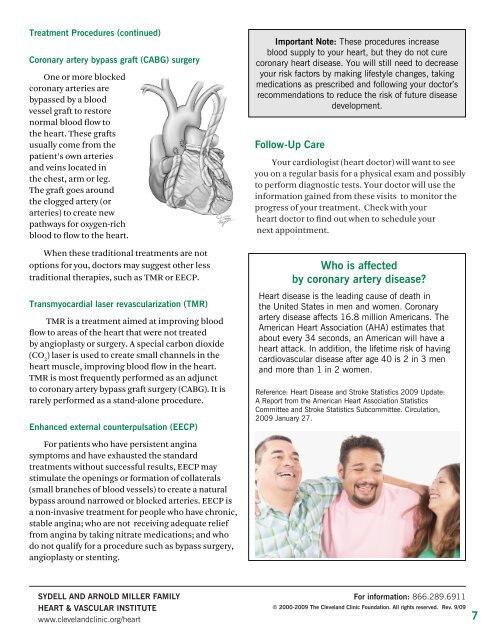Coronary Artery Disease Treatment Guide - Cleveland Clinic
Coronary Artery Disease Treatment Guide - Cleveland Clinic
Coronary Artery Disease Treatment Guide - Cleveland Clinic
You also want an ePaper? Increase the reach of your titles
YUMPU automatically turns print PDFs into web optimized ePapers that Google loves.
treatment Procedures (continued)<br />
<strong>Coronary</strong> artery bypass graft (CABg) surgery<br />
One or more blocked<br />
coronary arteries are<br />
bypassed by a blood<br />
vessel graft to restore<br />
normal blood flow to<br />
the heart. These grafts<br />
usually come from the<br />
patient’s own arteries<br />
and veins located in<br />
the chest, arm or leg.<br />
The graft goes around<br />
the clogged artery (or<br />
arteries) to create new<br />
pathways for oxygen-rich<br />
blood to flow to the heart.<br />
When these traditional treatments are not<br />
options for you, doctors may suggest other less<br />
traditional therapies, such as TMR or EECP.<br />
transmyocardial laser revascularization (tmR)<br />
TMR is a treatment aimed at improving blood<br />
flow to areas of the heart that were not treated<br />
by angioplasty or surgery. A special carbon dioxide<br />
(CO 2 ) laser is used to create small channels in the<br />
heart muscle, improving blood flow in the heart.<br />
TMR is most frequently performed as an adjunct<br />
to coronary artery bypass graft surgery (CABG). It is<br />
rarely performed as a stand-alone procedure.<br />
enhanced external counterpulsation (eeCP)<br />
For patients who have persistent angina<br />
symptoms and have exhausted the standard<br />
treatments without successful results, EECP may<br />
stimulate the openings or formation of collaterals<br />
(small branches of blood vessels) to create a natural<br />
bypass around narrowed or blocked arteries. EECP is<br />
a non-invasive treatment for people who have chronic,<br />
stable angina; who are not receiving adequate relief<br />
from angina by taking nitrate medications; and who<br />
do not qualify for a procedure such as bypass surgery,<br />
angioplasty or stenting.<br />
sydell And ARnold milleR FAmily<br />
heARt & vAsCulAR institute<br />
www.clevelandclinic.org/heart<br />
important note: These procedures increase<br />
blood supply to your heart, but they do not cure<br />
coronary heart disease. You will still need to decrease<br />
your risk factors by making lifestyle changes, taking<br />
medications as prescribed and following your doctor’s<br />
recommendations to reduce the risk of future disease<br />
development.<br />
Follow-up Care<br />
Your cardiologist (heart doctor) will want to see<br />
you on a regular basis for a physical exam and possibly<br />
to perform diagnostic tests. Your doctor will use the<br />
information gained from these visits to monitor the<br />
progress of your treatment. Check with your<br />
heart doctor to find out when to schedule your<br />
next appointment.<br />
Who is affected<br />
by coronary artery disease?<br />
Heart disease is the leading cause of death in<br />
the United States in men and women. <strong>Coronary</strong><br />
artery disease affects 16.8 million Americans. The<br />
American Heart Association (AHA) estimates that<br />
about every 34 seconds, an American will have a<br />
heart attack. In addition, the lifetime risk of having<br />
cardiovascular disease after age 40 is 2 in 3 men<br />
and more than 1 in 2 women.<br />
Reference: Heart <strong>Disease</strong> and Stroke Statistics 2009 Update:<br />
A Report from the American Heart Association Statistics<br />
Committee and Stroke Statistics Subcommittee. Circulation,<br />
2009 January 27.<br />
For information: 866.289.6911<br />
© 2000-2009 the <strong>Cleveland</strong> <strong>Clinic</strong> Foundation. All rights reserved. Rev. 9/09<br />
7

















